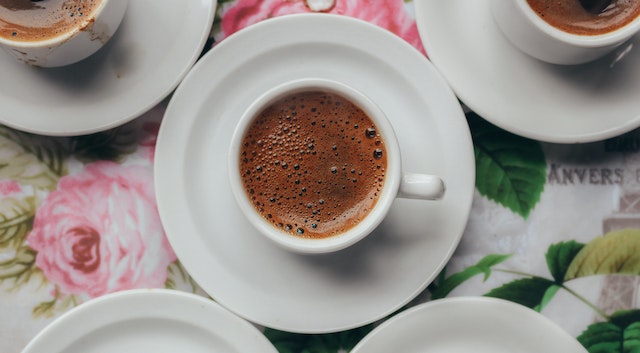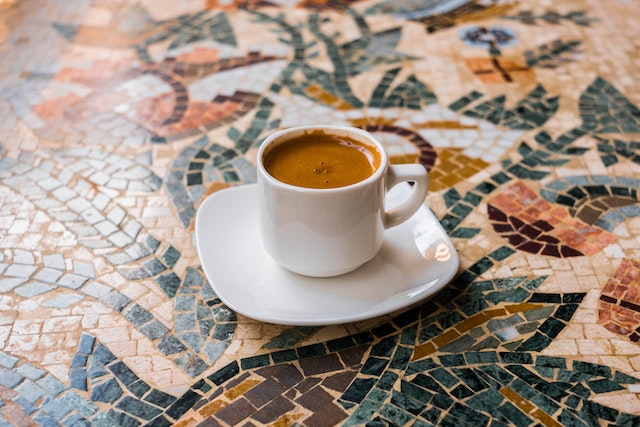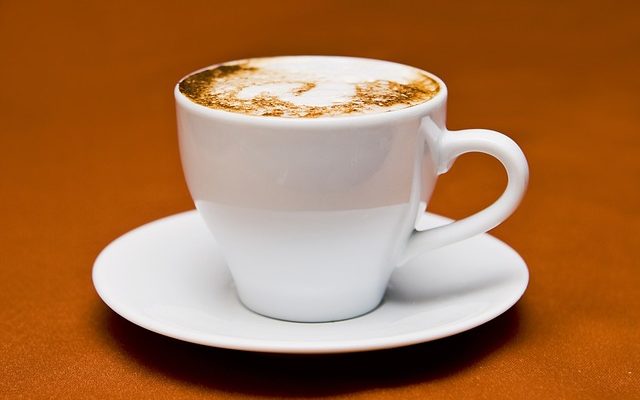Do you know how much caffeine is in an espresso shot? Many people don’t, and that’s because the amount of caffeine in an espresso can vary depending on the coffee bean blend, the roast, and the brewing method. In this blog post, we’ll break down all of that information for you and give you a better understanding of how much caffeine is in an espresso. We’ll also discuss the pros and cons of drinking espresso shots with high levels of caffeine. So, if you’re interested in learning more about caffeine levels in espressos, how much caffeine in an espresso shot? keep reading!
Table of Contents
About The Espresso Coffee
Espresso coffee is made by forcing hot water under high pressure through finely ground coffee beans. This results in a concentrated, full-flavored coffee with a thick layer of crema (foam) on top. Espresso is the basis for many other popular coffee drinks, including cappuccino, latte, mocha, and Americano.
Espresso is typically made with a special machine that has a boiler or pump that heats water to brewing temperature and forces it through the grounds at high pressure. The ideal brewing temperature for espresso is between 195 and 205 degrees Fahrenheit (91-96 degrees Celsius), and the ideal brewing pressure is 9 bars (130 pounds per square inch).
The result of this process is a small amount of very strong coffee with a thick layer of crema on top. The espresso should be dark brown in color with a slightly sweet taste.
Espresso has more caffeine per ounce than regular drip coffee, but since it is typically served in much smaller quantities, the overall caffeine content is usually about the same.
Espresso is a versatile coffee drink and can be enjoyed on its own or used as the base for other popular drinks like cappuccino, latte, mocha, and Americano.
How Much Caffeine In An Espresso Shot?

Espresso has long been praised for its coffee-house quality flavor and pick-me-up properties. And while an espresso shot may be small, it packs a big caffeine punch. So just how much caffeine is in an espresso shot?
While the answer may vary depending on the type of bean used and the roasting process, on average, an espresso shot contains about 64 mg of caffeine. To put that into perspective, a typical 8 oz cup of coffee contains around 95 mg of caffeine. So while an espresso may not have as much caffeine as a cup of coffee, its smaller serving size means that the caffeine concentration is actually higher.
So if you’re looking for a quick boost of energy, an espresso shot may be just what you need. Just be sure to enjoy it in moderation, as too much caffeine can lead to side effects like jitters, anxiety, and insomnia.
What Factors Affect The Amount Of Caffeine In An Espresso Shot?
As we all know, caffeine is a stimulant that can affect our nervous system. But did you know that there are actually several factors that can influence the amount of caffeine in an espresso shot? Let’s take a look at a few of them:
– The type of coffee bean: Different types of coffee beans contain different levels of caffeine. For example, Arabica beans generally have lower levels of caffeine than Robusta beans.
– The roast level: Darker roasts tend to have less caffeine than lighter roasts. This is because the roasting process causes the beans to lose some of their caffeine content.
– The brewing method: Espresso shots made with a finer grind will have more caffeine than those made with a coarser grind. This is because the finer grind allows more of the bean’s surface area to come into contact with the water, extracting more caffeine in the process.
– The amount of coffee used: Using more coffee in the brew will result in a higher caffeine shot. This is because there is simply more coffee to extract caffeine from.
– The extraction time: Allowing the espresso to brew for a longer period of time will also result in a higher caffeine shot. This is because the longer the brew time, the more time the water has to extract caffeine from the beans.
How much caffeine in an espresso shot? Keep these factors in mind the next time you’re looking to get a little extra kick from your espresso!
How Do I Know How Much Caffeine Is In My Espresso Shot?

There are a few ways to figure out how much caffeine is in your espresso shot. The first is to ask your barista – they should be able to give you a pretty accurate estimate. Another way is to look up the caffeine content of the coffee beans that were used to make your espresso. And finally, you can use a caffeine calculator like this one from Caffeine Informer.
Once you know the approximate caffeine content of your espresso shot, you can decide whether or not it’s right for you. If you’re sensitive to caffeine, you may want to stick to decaf espresso or choose another coffee drink altogether. But if you’re looking for a little boost, an espresso shot can be just the thing. Just be sure to enjoy it in moderation!
What Kind Of Coffee Is Used For Espresso?
There are many different types of coffee that can be used for espresso, but the two most popular choices are Arabica and Robusta beans. Arabica beans are typically used in higher-end coffees, as they provide a more complex flavor profile with notes of fruit and floral aromatics. Robusta beans, on the other hand, are often used in more budget-friendly coffees or blends; they have a harsher, more bitter flavor and higher caffeine content. Ultimately, the best coffee for espresso is going to be a matter of personal preference – so experiment with different types of beans (or even different roasts) until you find your perfect cup!
>>> Read more:
How Long Should An Espresso Shot Take?
This is a common question among coffee lovers, and the answer may surprise you.
Espresso is made by forcing hot water through finely ground coffee beans. The process of making espresso is called extraction, and it normally takes 20-30 seconds to extract a shot of espresso. However, the length of time that an espresso shot takes can vary depending on several factors.
The grind of the coffee beans is one factor that can affect the extraction time. If the beans are ground too coarsely, the water will flow through them too quickly and the espresso will be weak. If the beans are ground too finely, the water will have trouble flowing through them and the espresso will be bitter. The grind should be somewhere in between these two extremes for the best results.
The type of coffee beans can also affect the extraction time. Arabica beans are typically used for espresso, as they have a higher acidity and yield a more balanced shot. Robusta beans are sometimes used as well, but they tend to produce a harsher espresso with more bitterness.
The temperature of the water is also important for espresso extraction. If the water is too cold, it will not extract all of the flavor from the beans. If the water is too hot, it can scald the beans and make them taste burnt. The ideal water temperature for espresso is around 200 degrees Fahrenheit.
Finally, the amount of pressure that is used to brew the espresso can also affect the extraction time. Higher pressure will extract more flavors from the beans, but it can also make the espresso taste bitter if it is not balanced with the other factors.
In general, an espresso shot should take 20-30 seconds to extract. However, there is no need to be overly precise about it. As long as the coffee tastes good, that is all that matters!
How Big Is An Espresso Shot?

A typical espresso shot contains about 1 fluid ounce (30ml) of coffee. However, the actual amount of coffee in an espresso shot can vary depending on the size of the cup or mug used. For example, a “double shot” of espresso may contain 2 fluid ounces (60ml) of coffee.
The size of an espresso shot is also affected by the grind size of the coffee beans. A finer grind will result in a smaller volume of coffee, while a coarser grind will produce a larger volume.
Generally speaking, an espresso shot should contain between 18-22 grams of coffee grounds. This will yield around 1 fluid ounce (30ml) of coffee when brewed.
How much caffeine in an espresso shot? It’s also worth noting that espresso shots are often double or even triple the size of a standard coffee cup. So, if you’re ordering an espresso at your local coffee shop, be aware that you may be getting more than you bargained for!
How Much Coffee Do You Use For Espresso?
Now that we’ve covered the basics of espresso, let’s move on to how much coffee you should use for espresso. This is a important question because using too little coffee will result in a weak and watery espresso, while using too much coffee will make the espresso bitter.
The perfect amount of coffee to use for espresso is called the “dose.” The dose is typically between 18-21 grams of coffee, depending on the size of your espresso machine’s portafilter. To measure out the perfect dose, you’ll need a food scale.
Once you have your dose of coffee, it’s time to grind the beans. The grind size for espresso is very fine, so you’ll need a quality burr grinder. We recommend starting with a grind size of around 20 on your grinder’s settings. If your espresso is coming out too weak, try grinding the beans a bit finer. If it’s coming out too bitter, try grinding them a bit coarser.
Now that you have the perfect dose of freshly ground coffee, it’s time to brew your espresso! Follow the instructions on your espresso machine to make sure you’re using the right amount of water and pressure. Then sit back and enjoy the fruits of your labor. A perfectly brewed espresso should be rich and flavorful, with a thick layer of crema on top.
>>> See more: Pulling the Perfect Espresso Shot
How Much Liquid Is In An Espresso Shot?
An espresso shot is a small amount of coffee, usually about 1 ounce or 30 milliliters. This means that there is not a lot of liquid in an espresso shot. However, the coffee is very concentrated and has a strong flavor. Espresso shots are typically used as a base for other coffee drinks, such as lattes and cappuccinos. If you are looking for a strong coffee flavor, an espresso shot is a good option.
FAQs About How Much Caffeine In An Espresso Shot?
What Are The Health Benefits Of Caffeine?
Caffeine is a stimulant that can help to improve mental alertness and focus. It can also increase physical endurance and performance. Caffeine is often used as a pre-workout supplement because it can help to improve energy levels and stamina. In addition to these benefits, caffeine has also been shown to boost metabolism and promote weight loss.
How Do I Know When My Espresso Is Done?
It can be tricky to know when your espresso is done. Here are a few things to keep in mind:
– The espresso should be a deep, dark brown color.
– The crema (the foamy layer on top of the espresso) should be thick and rich.
– The espresso should have a strong aroma.
If you’re unsure, it’s always better to err on the side of caution and pull the shot sooner rather than later. Better too weak than too bitter!
What Are The Rules For Espresso?
When it comes to making espresso, there are a few key rules that you need to follow in order to make the perfect cup. First and foremost, you need to use high quality coffee beans that have been freshly ground. The grind should be fine, but not too fine – if it’s too fine, the water will have difficulty flowing through the grounds and extracting all of the flavor.
Next, you’ll need to tamp the grounds evenly into the filter before brewing. This helps ensure that water flows evenly through the coffee and extracts all of the flavor. Once tamped, start the brewing process and don’t allow the water to flow for more than 30 seconds – otherwise your espresso will be over-extracted and bitter.
Finally, once brewed, the espresso should be served immediately. If left to sit, it will continue to extract and become more bitter. So pull a shot, add any desired milk or sugar, and enjoy!
How Much Caffeine Is Too Much?
Most healthy adults can safely consume up to 400mg of caffeine per day. However, pregnant women and people with certain medical conditions should limit their intake. Consuming more than 600mg of caffeine per day has been linked to side effects such as anxiety, jitters, and insomnia. Excessive caffeine consumption can also lead to addiction and withdrawal symptoms.
If you’re looking for an energy boost, a cup of coffee or a can of soda may be a better option than an espresso shot. This is because they contain less caffeine and are less likely to cause side effects. However, if you’re seeking the health benefits of caffeine, moderate consumption of espresso is safe and may offer some benefits.
How Do I Make Espresso Coffee?
To make espresso, you will need an espresso machine. There are many different types and brands of espresso machines on the market, so it is important to do your research before purchasing one. Once you have your machine, follow the instructions that come with it to make your perfect cup of espresso.
What Is The Difference Between Espresso And Coffee?
Espresso is a type of coffee that is made by forcing hot water through finely ground coffee beans. This results in a strong, concentrated coffee that has a unique flavor. Coffee, on the other hand, is brewed using hot water that is passed through coarser ground beans. This produces a weaker drink that has a more mellow flavor.
What Are The Benefits Of Drinking Espresso?
Espresso contains more caffeine than regular coffee, so it can give you a boost of energy. It also has a higher concentration of antioxidants, which can help to protect your body from damage caused by free radicals. Additionally, the unique flavor of espresso can be a great way to add variety to your coffee repertoire.
How Should I Drink Espresso?
There is no right or wrong answer to this question – it all comes down to personal preference. Some people like to drink their espresso straight, while others prefer to add milk or cream. If you are adding milk or cream, steamed milk is generally preferable to cold milk as it helps to bring out the flavor of the espresso. Experiment and see what you like best!
Conclusion
How much caffeine in an espresso shot? If you are ever wondering how much caffeine is in an espresso shot, the answer is about 64 mg. This amount of caffeine can vary slightly depending on the type of beans used and how long the shot is brewed for. If you are sensitive to caffeine, it is best to stick to one ounce servings or choose a decaffeinated option. Now that you know how much caffeine is in an espresso shot, enjoy your next cup! Follow Cafe Toscana Restaurant to update the best articles!

